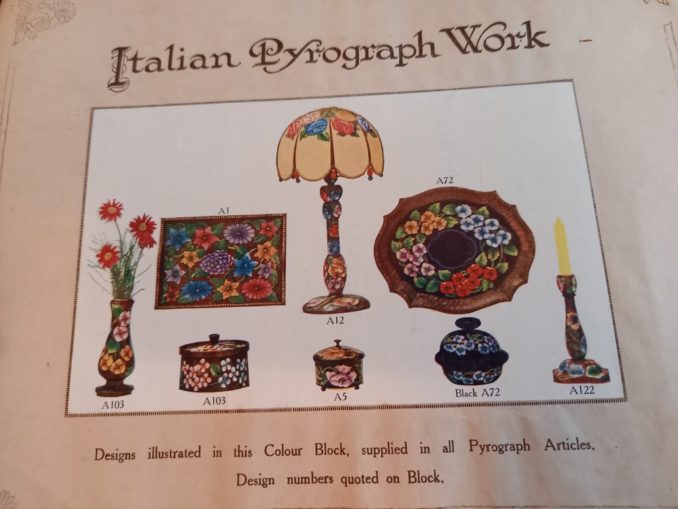
© Chrissie 2021
Background
Known as “pokerwork” until the late 19th Century, it is believed that this form of applied art has been practiced since Prehistoric times. At its most basic, it involves the burning of pictures or patterns into a soft material, such as wood or leather, using implements as simple as metal rods heated in fire.
It is easy to imagine the Prehistoric artist, after his labours in “painting” buffaloes and hunters on the walls of his cave, finding that he could heat some kind of implement in the embers of his fire and produce designs on a softer material, such as leather or gourds.
As with many Prehistoric artefacts, no examples exist, and the earliest known example, from Peru, is dated around 700 BC. It is also known that it was an art form practiced in Iran as well as in China during the Han Dynasty (200 BC – 200 AD), where it was known as “fire needle embroidery”. It was an art also practiced by native people in North America and Australia.
In the Middle Ages, the invention of a portable stove with holes in the top enabled several pokers to be heated at once, (hence the expression “having more than one iron in the fire”), and it is likely that blacksmiths were heavily involved in the production of domestic poker work.
Pyrography is born
At the turn of the 20th Century, the process was revolutionized by an Australian Architect, Alfred Smart, who produced a hollow platinum pencil attached to a bottle of benzene, through which benzene gas could be pumped (by means of a rubber ball) to keep the rods hot during the artistic process: this was later electrified. The new process enabled shading to be introduced, expanding the previous artistic possibilities.
At the same time, the pervading style, Art Nouveau, had an enormous influence on the styles and colours of the decoration which gave way to sinuous designs of plants, flowers and young women in vibrant tints. The new designs were adopted at around the same time in Italy, France and Belgium, but never, as far as I can establish, in the UK.
At this time, the name was changed to “pyrography”, although, in America, it continued to be widely called “wood burning”, and the artefacts produced “burnt wood”.
At the same time, pyrography changed from a male activity to an essentially female occupation, as companies, such as Sears, offered pyrography kits by mail order.
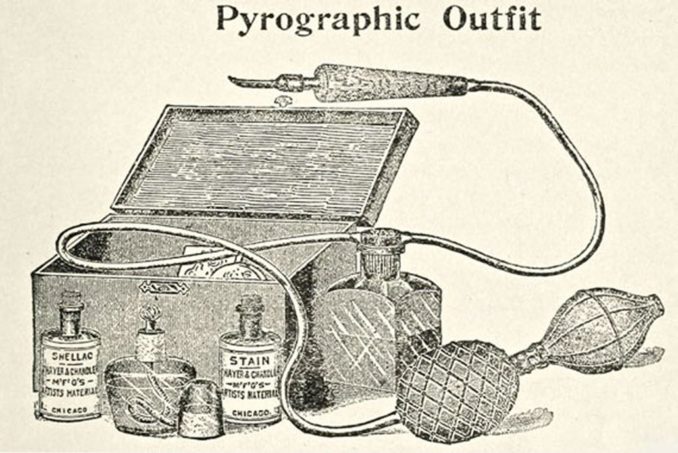
Library of Congress
Pyrography and me
At some time in the last twenty years, I no longer remember where or when, I saw an item of pyrography, and liked it. It was not so much the wood burning that appealed to me, but the classic Art Nouveau designs. As an aside, it has become clear to me over the years that I was born 60 years or so too late since my taste in applied art is grounded in the short 20 year life span of the Art Nouveau movement (1890 – 1920).
Once I had discovered pyrography, I turned to EBay (English, Italian and French sites), Etsy and similar sites, as is my wont, to satisfy my new acquisitive urge.
Eureka
It was on one of these perambulations that an early UK vendor’s catalogue flashed before my eyes, and, the minute I saw it, I knew it had to be mine. This sales document featured FIBLA Pyrograph products, made in Italy,
The brochure was produced by Pike Bros & Co Ltd, manufacturers of silk products, based at 1. Bayer Street, Golden Lane, London EC1, which had exclusive distribution rights in the United Kingdom, Colonies and Southern Ireland. It features 20 pages of products, (at around 20 per page), i.e. around 400 products. There are four pages of table and standard lamps with a further page of lampshades, six pages of powder bowls, two pages of trays and an assortment of mirrors, clocks, ashtrays and even tables.
The brochure included a number of loose inserts and a price list, which highlighted just how expensive these items (presumably made by outworkers) were. They obviously represented a considerable investment for the aspiring Middle Class housewife.
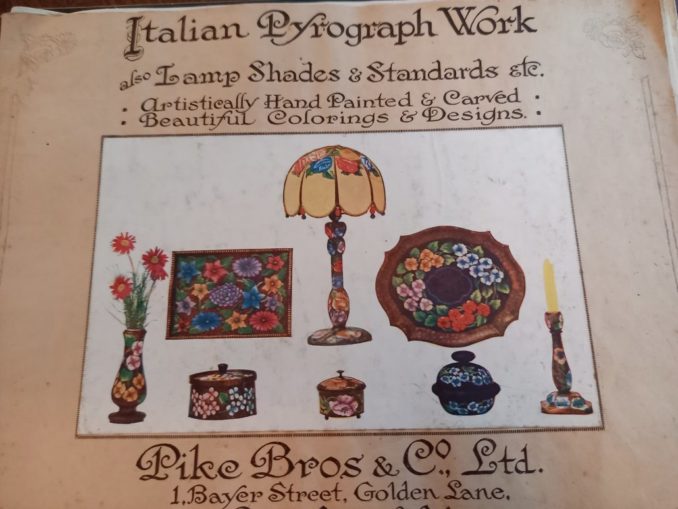
© Chrissie 2021
For example, the table lamp shown on the frontispiece was priced at 45/ for a 15” high model. It does not sound a lot, but in today’s prices it would be £296: the vase was 8/11 (£59) and the candlestick 5/11 for a 9” model (£39). The most expensive items in the catalogue are a trinket set of 10 pieces, including a tray, 2 candlesticks, 2 clothes brushes, 2 powder bowls, a pin tray, hand mirror and hair brush, priced at 85/ (£559) and a 5’ standard lamp for £6-16-0 (£895).
Despite the prices, how could the discerning housewife resist “The artistic temperament of Italy fully exemplified in the CHASTE DESIGNS, BEAUTIFUL COLOURINGS AND EXCELLENT WORKMANSHIP of these articles (which) add beauty to ‘My Lady’s Boudoir’, give added charm to the Dining Room and, in their wide and useful range, betoken refinement and grace to the house.” And, in case she was wavering, she was reassured by, “Designed by Italian artists, with centuries of art-craft in their veins, the carvings are pyrographed and hand-coloured, the process involving several secret methods of treatment whereby the perfectly harmonised colours stand out in remarkable beauty and are rendered permanent.” (Unfortunately, not true!)
Pike Bros exhibited at the 1922 trade Fair at Chrystal Palace, but I can find no trace of them after this point. The area in which their premises were based, Clerkenwell, was known as “Little Italy”, due to the number of Italian immigrants who had settled there, but their premises now appear to be a residential development in the People’s Republic of Islington .
Collecting pyrography
Interestingly enough, none of my collection came from my friends in Clerkenwell, because everything I have is pyrographed as “Made in France”. It is, however, clear that the same patterns were being used throughout Europe, as the designs in my collection are exactly the same as those in the Pike Bros catalogue of Italian artefacts.
In order to demonstrate that the coloured illustrations in the catalogue fall far short of the beauty of high quality examples, I have included photographs of a couple of items from my collection, a tall powder bowl and a lamp, which show the vibrancy of well-preserved items.
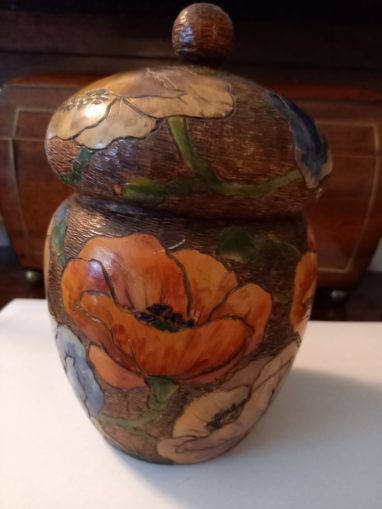
© Chrissie 2021
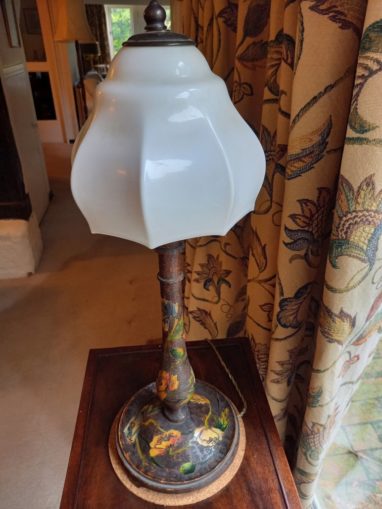
© Chrissie 2021
I believe there are three kinds of collector:-
Those who love those items they collect, and are happy (even delighted) to share them with others.
Collectors with no particular love of the items collected, whose prime motivation is investment, the hope that what they collect will significantly increase in value.
Possessive collectors who covet items so much that they are prepared to pay others to steal them so that they can gloat over them, inevitably in solitude.
I am quite firmly in the first camp, and, while I would never force my treasures on anyone, I am delighted if people ask me about them. Having said this, I am happy to admit that, in the field of pyrography, I have considerably more failures than successes, and the latter tend to remain hidden in areas where guests never go.
As with so many areas of collecting, the main problem is finding items of sufficient quality. I looked on EBay before writing this, and everything featured on the site (most of it from Bulgaria) looked as though it had been produced last week. The patterns looked for all the world like those I saw on painted boxes in the USSR in 1971, and the colours were garish rather than vibrant: none of them resembled the sinuous beauty of Art Nouveau.
Another problem is that the cost of purchasing from outside the UK has clearly increased by the imposition of 20% VAT and (is it my imagination?) significantly increased postal costs.
Nevertheless, there will be quality items out there for those with the patience to wait for them, and, as a collector who has made so many mistakes in the past, my top tip to anyone thinking of collecting pyrography is to wait patiently for as long as necessary for the right piece to come along, and my second tip, be prepared to pay for it.
The two tips above apply to any form of collecting, but there is another very important tip to collecting pyrography, which is to check, check and check again whether the colours of the item have faded or not. Most pyrography on sale has faded, and pyrography which has faded is a very poor ghost of the vibrant beauty it started as.
As with many other decorative items, it is the sun shining on them which destroys their vibrant colours. Unfortunately, clever photography can make the most pedestrian of items appear truly delightful: make sure you ask any vendor for more photographs to reassure yourself that the item is one you really do want to live with for ever.
The design is also an important indicator of age. Pyrography lasted well into the Art Deco period, and, unless it is a period you prefer, you may wish to exclude these items.
By the same token, you will want to ensure that the item is genuine, and not knocked up last week in a garage down the Lye. The key here is to ask for a photograph of the base: if it is the genuine article, the base will be extensively pyrographed, including “Made in France” or similar.
A Quirky One

© Chrissie 2021
Finally, I would like to show you something entirely different. It is a powder bowl made in France at exactly the right turn of the century period, but it is totally different from the usual Art Nouveau pyrography examples, being designed with small theatre-related symbols, such as masks. It was obviously produced specifically for a luvvie of the times, but who or why I will, unfortunately, never know.
For me, these one-offs are one of the delights of collecting: you think you know it all, but now and again you discover that there are more things in heaven and earth….
The Future
My days of pyrography collecting are over: apart from any other consideration, I have run out of space in my cottage. I am not saying I wouldn’t be tempted if I happened to come across a delectable piece, (a temptation which, on past experience, I would be unable to resist), but I no longer actively seek them out. In fact, it might be time to dispose of some of my purchasing mistakes (if only I could be bothered – which I am the first to confess is unlikely!).
However, there may be Puffins who are tempted to “dip their toes” in to this fascinating area. To any who are, may I be the first to wish you every success.
Alternatively, with pyrography kits widely available on sites such as Amazon, it may be that some of the many talented Puffins, who are dab hands with soldering irons and similar tools, might be tempted to turn their hands to creating the beautiful pyrography of the future. If there are, I look forward keenly to seeing the fruits of their labours.
© Chrissie 2021



